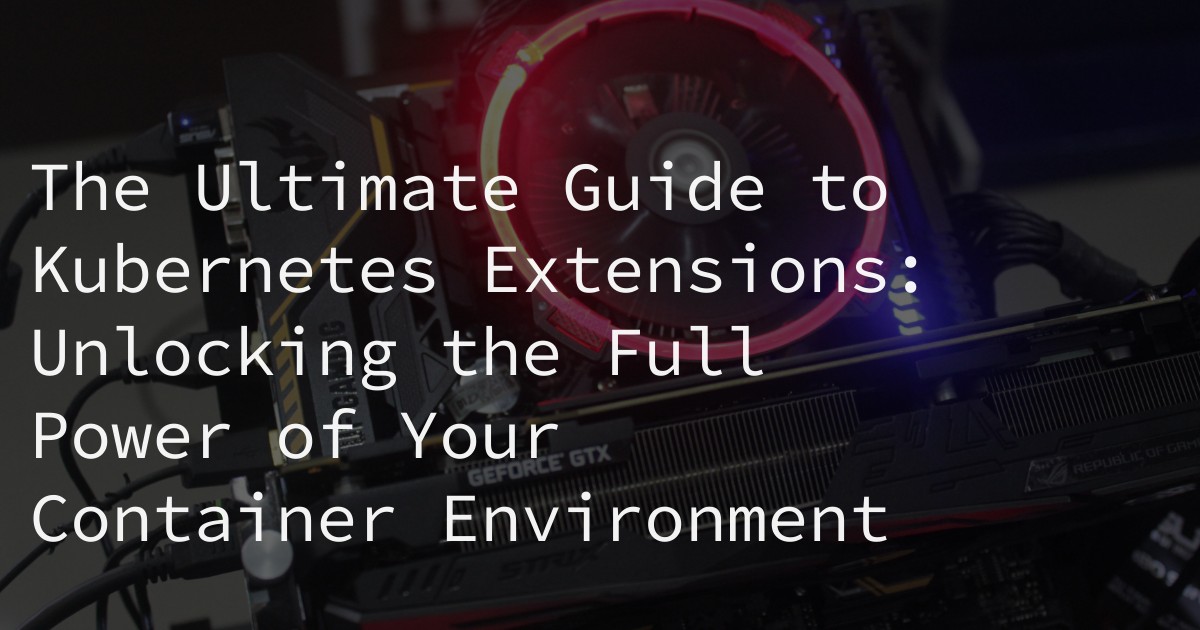
31 Oct The Ultimate Guide to Kubernetes Extensions: Unlocking the Full Power of Your Container Environment
Kubernetes extensions are a crucial aspect of maximizing the potential of container environments. As a SEO and Cloud Computing expert, I have seen the impact that these extensions can have on improving the performance and capabilities of Kubernetes. In this comprehensive guide, we will dive into everything you need to know about Kubernetes extensions, from their definition and purpose to a step-by-step guide on implementing and managing them. By the end of this article, you will have a thorough understanding of how to unlock the full power of your container environment with Kubernetes extensions.
What are Kubernetes Extensions?
Kubernetes extensions are add-ons or plugins that enhance the functionality of the Kubernetes platform. They are designed to extend the capabilities of Kubernetes and provide additional features that are not available in the core platform. These extensions can be used to improve networking, storage, security, service mesh, logging, monitoring, tracing, and CI/CD pipelines in a Kubernetes environment.
The use of extensions in Kubernetes is becoming increasingly popular as organizations look to optimize their container environments. These extensions offer a range of benefits, including improved performance, increased security, and enhanced automation. They also allow for greater customization and flexibility in managing Kubernetes clusters.
Comprehensive Overview of Kubernetes Extensions
There are various types of Kubernetes extensions that cater to different aspects of a container environment. Let’s take a closer look at each type and some popular examples.
Network Extensions
Network extensions are used to enhance the networking capabilities of Kubernetes. They provide features such as load balancing, network isolation, and network policies. Some popular network extensions for Kubernetes include:
- Calico
- Weave Net
- Cilium
These extensions can be implemented and managed through the Kubernetes API or through third-party tools.
Storage Extensions
Storage extensions are used to improve the storage capabilities of Kubernetes. They provide features such as persistent storage, data replication, and data protection. Some popular storage extensions for Kubernetes include:
- Rook
- Portworx
- GlusterFS
These extensions can be implemented and managed through the Kubernetes API or through third-party tools.
ALSO READ
Security Extensions
Security extensions are used to enhance the security of Kubernetes clusters. They provide features such as vulnerability scanning, access control, and threat detection. Some popular security extensions for Kubernetes include:
- Falco
- Aqua Security
- Sysdig Secure
These extensions can be implemented and managed through the Kubernetes API or through third-party tools.
Service Mesh Extensions
Service mesh extensions are used to improve the communication between microservices in a Kubernetes environment. They provide features such as traffic routing, load balancing, and service discovery. Some popular service mesh extensions for Kubernetes include:
- Istio
- Linkerd
- Consul
These extensions can be implemented and managed through the Kubernetes API or through third-party tools.
ALSO READ
Logging, Monitoring, and Tracing Extensions
Logging, monitoring, and tracing extensions are used to improve the observability of Kubernetes clusters. They provide features such as log aggregation, metrics collection, and distributed tracing. Some popular extensions for logging, monitoring, and tracing in Kubernetes include:
- Prometheus
- Fluentd
- Jaeger
These extensions can be implemented and managed through the Kubernetes API or through third-party tools.
CI/CD Pipelines Extensions
CI/CD pipelines extensions are used to automate the deployment and delivery of applications in a Kubernetes environment. They provide features such as continuous integration, continuous delivery, and automated testing. Some popular extensions for CI/CD pipelines in Kubernetes include:
- Jenkins
- GitLab
- Spinnaker
These extensions can be implemented and managed through the Kubernetes API or through third-party tools.
Step-by-Step Guide to Implementing and Managing Kubernetes Extensions
Now that we have a comprehensive overview of Kubernetes extensions, let’s dive into the steps for implementing and managing them in your container environment.
1. Prepare your Kubernetes environment for extensions by ensuring that it meets the necessary requirements and has the appropriate resources.
2. Install and configure the desired extensions using the Kubernetes API or through third-party tools.
3. Follow best practices for managing and maintaining extensions, such as regularly updating and monitoring them.
Unlocking the Full Power of Your Container Environment with Kubernetes Extensions
Kubernetes extensions play a crucial role in enhancing the capabilities of container environments. By utilizing these extensions, organizations can improve the performance, security, and automation of their Kubernetes clusters. Let’s take a look at some real-world examples of organizations using extensions to improve their container environments:
- Netflix uses service mesh extensions to manage the communication between its microservices in a highly dynamic and scalable manner.
- Spotify uses logging, monitoring, and tracing extensions to gain insights into the performance of its applications and troubleshoot any issues.
- Amazon uses security extensions to ensure the security of its Kubernetes clusters and protect against potential threats.
The future of Kubernetes extensions looks promising, with ongoing developments and advancements in the field. As the adoption of Kubernetes continues to grow, we can expect to see even more innovative and powerful extensions being developed.
Conclusion
In conclusion, Kubernetes extensions are essential for unlocking the full potential of container environments. They offer a range of benefits and can significantly enhance the capabilities of Kubernetes. By following the steps outlined in this guide, you can successfully implement and manage extensions in your Kubernetes environment. Don’t miss out on the opportunity to optimize your container environment with these powerful extensions.
References
- https://kubernetes.io/docs/concepts/extend-kubernetes/
- https://www.redhat.com/en/topics/containers/what-are-kubernetes-extensions
- https://www.cncf.io/blog/2019/02/13/why-kubernetes-extensions-are-important/
- https://www.infoq.com/articles/kubernetes-extensions/
- https://www.cloudbees.com/blog/ultimate-guide-kubernetes-extensions
RELATED ARTICLES:



Sorry, the comment form is closed at this time.